ASRock Industrial 4X4 BOX-7735U UCFF PC Review: Zen 3+, RDNA2, and USB4 in a Potent Platform
by Ganesh T S on April 6, 2023 10:30 AM EST- Posted in
- Systems
- AMD
- UCFF
- USB4
- ASRock Industrial
- Rembrandt
- Ryzen 7000 Mobile
System Performance: Miscellaneous Workloads
Standardized benchmarks such as UL's PCMark 10 and BAPCo's SYSmark take a holistic view of the system and process a wide range of workloads to arrive at a single score. Some systems are required to excel at specific tasks - so it is often helpful to see how a computer performs in specific scenarios such as rendering, transcoding, JavaScript execution (web browsing), etc. This section presents focused benchmark numbers for specific application scenarios.
3D Rendering - CINEBENCH R23
We use CINEBENCH R23 for 3D rendering evaluation. R23 provides two benchmark modes - single threaded and multi-threaded. Evaluation of different PC configurations in both supported modes provided us the following results. Similar to one of the PCMark 10 workload components, we see single-threaded performance for the 28W configuration being better than the 42W configuration. However, things return to normal in the mult-threaded case.
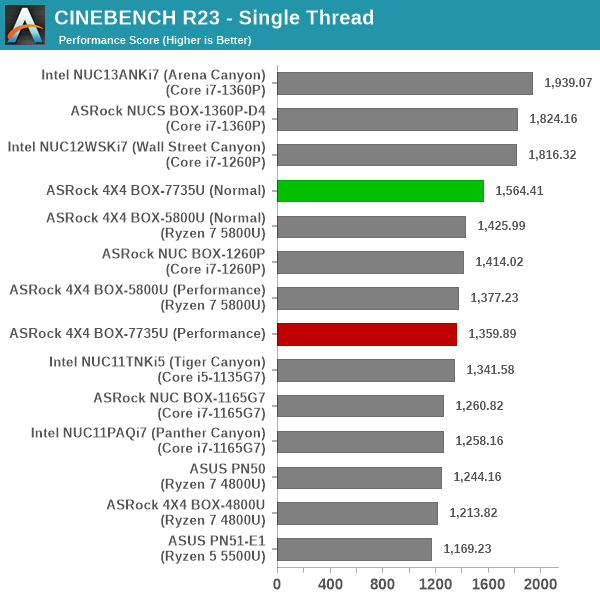
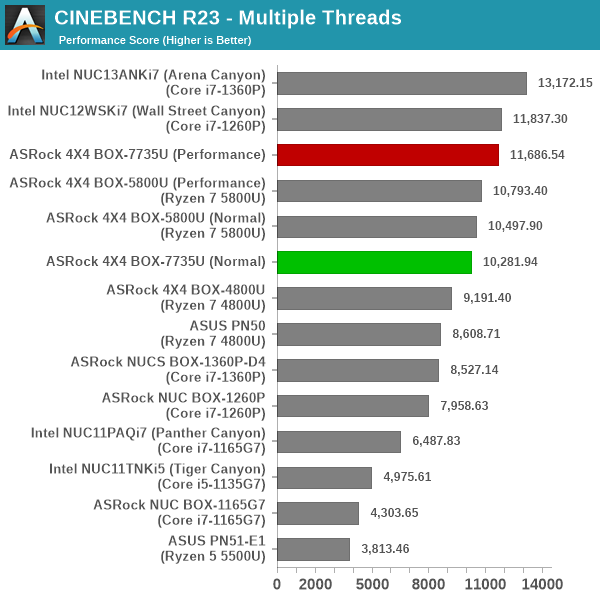
With both ADL-P and RPL-P matching on thread counts (and actually having more, albeit weaker, cores), both ST and MT performance of Rembrandt-R is weak on a comparative basis. However, it is still a solid step up from Cezanne.
Transcoding: Handbrake 1.5.1
Handbrake is one of the most user-friendly open source transcoding front-ends in the market. It allows users to opt for either software-based higher quality processing or hardware-based fast processing in their transcoding jobs. Our new test suite uses the 'Tears of Steel' 4K AVC video as input and transcodes it with a quality setting of 19 to create a 720p AVC stream and a 1080p HEVC stream.
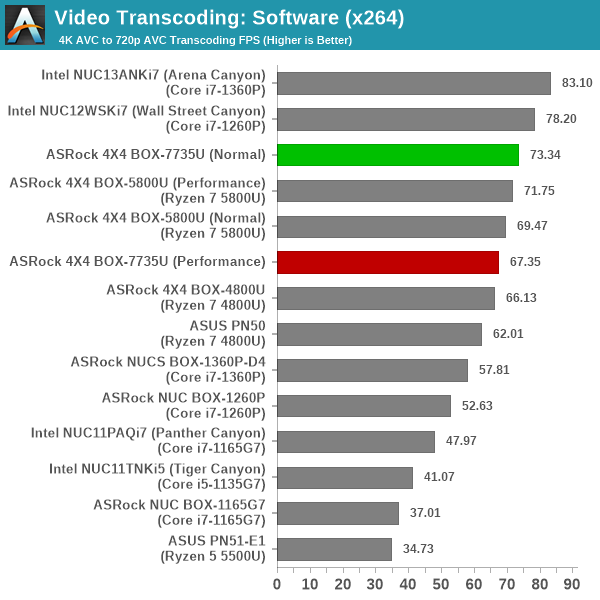
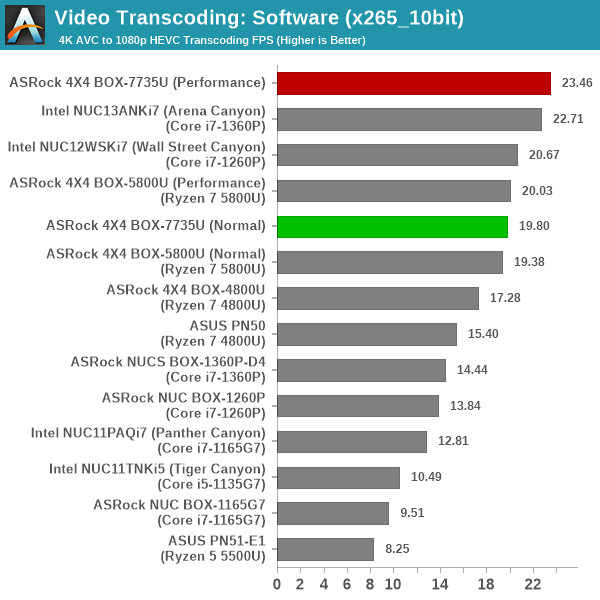
The features used in the x264 workload are more amenable to the heterogeneous processors. However, for x265, we see that a larger number of high-performance cores will outperform the rest when provided similar power envelopes.
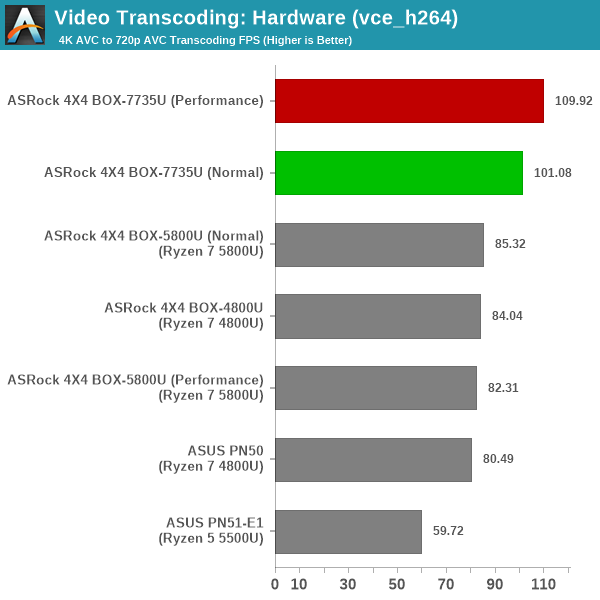
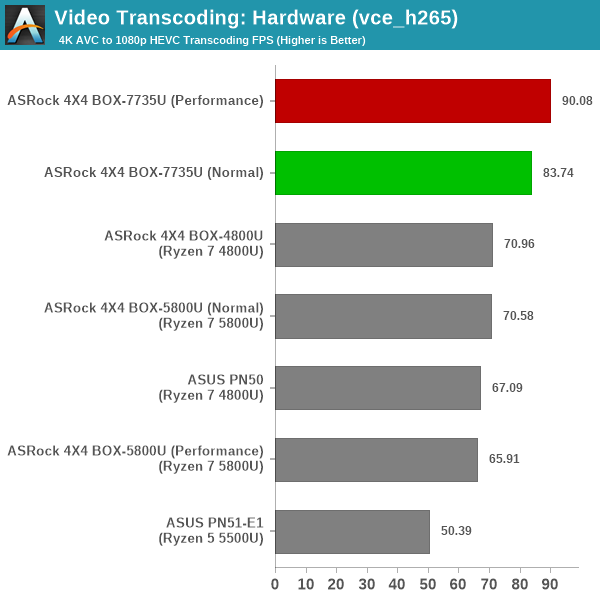
It does not make sense to compare VCE and QSV encoding performance, as the quality of the resultant files are completely different. So, we only look at VCE results here. The VCN engine is clocked at 1.44 GHz - much higher than the previous generation - allowing it to deliver 15%+ performance at similar power envelopes as Cezanne.
Archiving: 7-Zip 21.7
The 7-Zip benchmark is carried over from our previous test suite with an update to the latest version of the open source compression / decompression software.
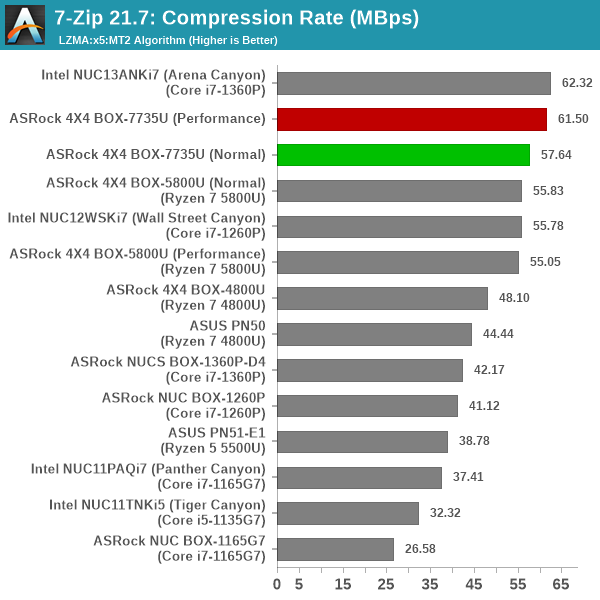
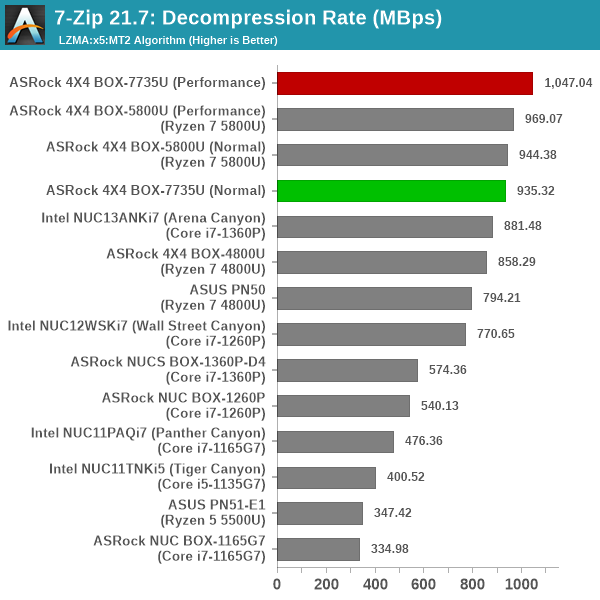
Larger number of high-performance cores helps the Rembrandt-R system gain an edge in the decompression case. However, the competition is much more fierce in the other direction, with both the Arena Canyon NUC and the 4X4 BOX-7735U/D5 delivering similar compression rates at the 40W TDP point.
Web Browsing: JetStream, Speedometer, and Principled Technologies WebXPRT4
Web browser-based workloads have emerged as a major component of the typical home and business PC usage scenarios. For headless systems, many applications based on JavaScript are becoming relevant too. In order to evaluate systems for their JavaScript execution efficiency, we are carrying over the browser-focused benchmarks from the WebKit developers used in our notebook reviews. Hosted at BrowserBench, JetStream 2.0 benchmarks JavaScript and WebAssembly performance, while Speedometer measures web application responsiveness.
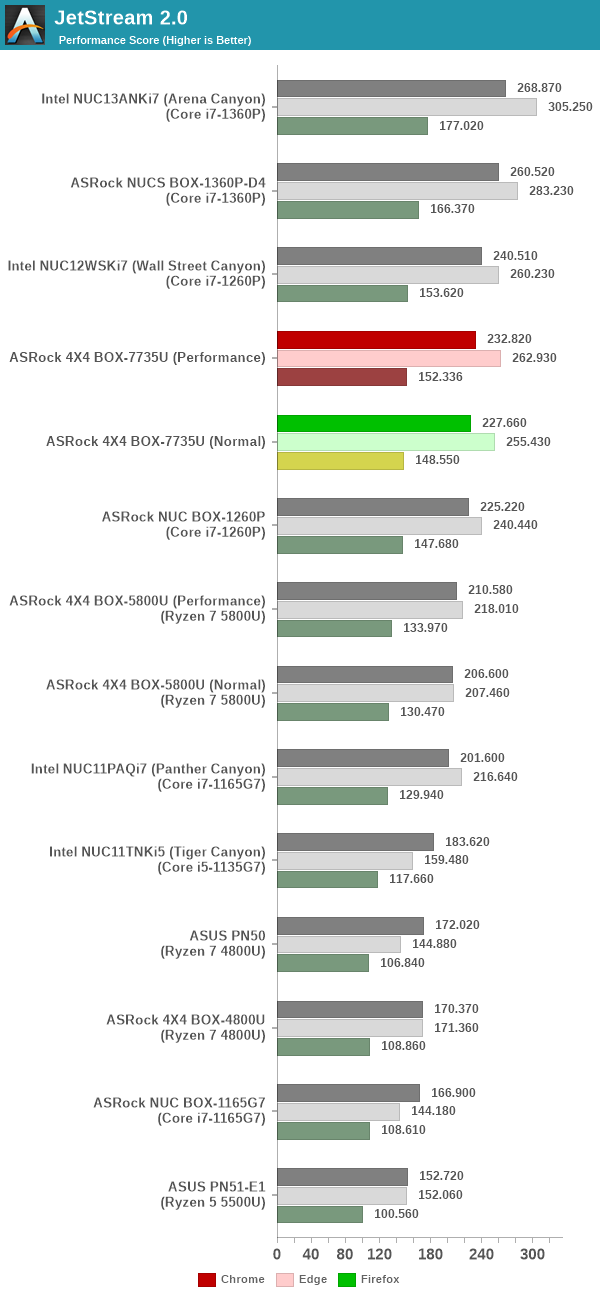

From a real-life workload perspective, we also process WebXPRT4 from Principled Technologies. WebXPRT4 benchmarks the performance of some popular JavaScript libraries that are widely used in websites.
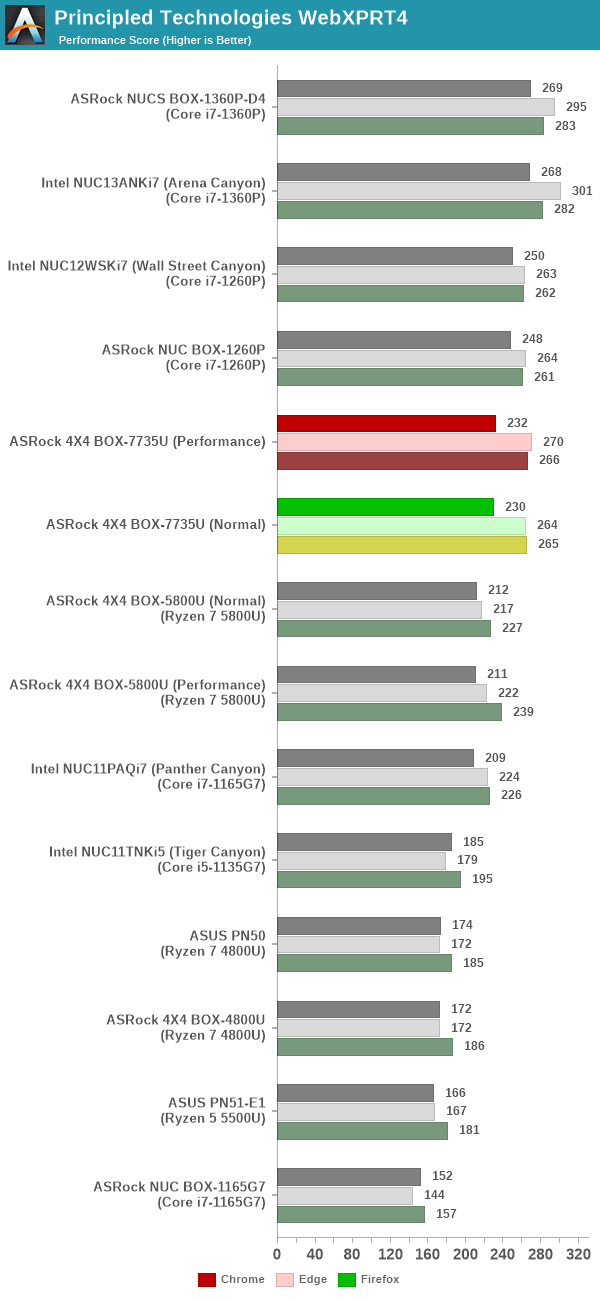
Across all web browsing tests, the systems equipped with heterogeneous processors appear in the top half. However, the Rembrandt-R configurations are right behind them (and would have been on top without ADL-P and RPL-P in the picture).
Application Startup: GIMP 2.10.30
A new addition to our systems test suite is AppTimer - a benchmark that loads up a program and determines how long it takes for it to accept user inputs. We use GIMP 2.10.30 with a 50MB multi-layered xcf file as input. What we test here is the first run as well as the cached run - normally on the first time a user loads the GIMP package from a fresh install, the system has to configure a few dozen files that remain optimized on subsequent opening. For our test we delete those configured optimized files in order to force a fresh load every second time the software is run.

As it turns out, GIMP does optimizations for every CPU thread in the system, which requires that higher thread-count processors take a lot longer to run. So the test runs quick on systems with fewer threads, however fast cores are also needed. The end result is that heterogeneous systems with non-threaded E cores have a slight advantage over the rest of the pack.
Cryptography Benchmarks
Cryptography has become an indispensable part of our interaction with computing systems. Almost all modern systems have some sort of hardware-acceleration for making cryptographic operations faster and more power efficient. In the case of IoT servers, many applications - including web server functionality and VPN - need cryptography acceleration.
BitLocker is a Windows features that encrypts entire disk volumes. While drives that offer encryption capabilities are dealt with using that feature, most legacy systems and external drives have to use the host system implementation. Windows has no direct benchmark for BitLocker. However, we cooked up a BitLocker operation sequence to determine the adeptness of the system at handling BitLocker operations. We start off with a 4.5GB RAM drive in which a 4GB VHD (virtual hard disk) is created. This VHD is then mounted, and BitLocker is enabled on the volume. Once the BitLocker encryption process gets done, BitLocker is disabled. This triggers a decryption process. The times taken to complete the encryption and decryption are recorded. This process is repeated 25 times, and the average of the last 20 iterations is graphed below.
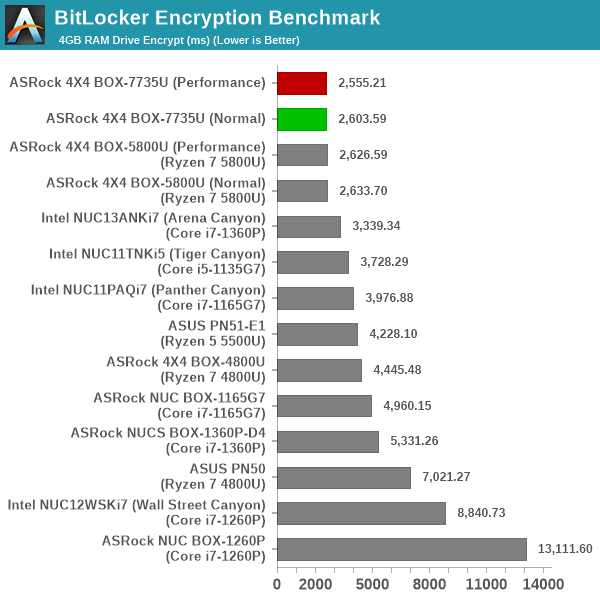
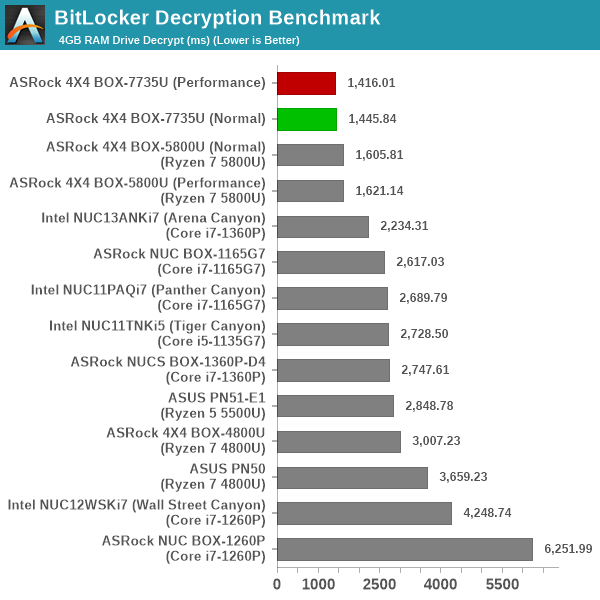
Hardware acceleration is available for the operations in all of the systems. The time taken for processing is directly dependent on the available power budget within each vendor (Intel or AMD). AMD has historically held the edge in these types of workloads, and that continues with Rembrandt-R.










35 Comments
View All Comments
AntonErtl - Friday, April 7, 2023 - link
Looking at the AMD specs for the CPU, it supports ECC if the platform does. Does the platform support ECC?A fanless variant (possibly with a lower power limit and a larger box) would be nice for the desktop, but (I guess) also for a number of industrial environments.
heffeque - Friday, April 7, 2023 - link
Disappointed with AV1 decoding.AMD needs to fix that ASAP.
Hamm Burger - Saturday, April 8, 2023 - link
For the benchmarks I could easily reproduce*, the figures for this PC are very similar to those for the (considerably more expensive, and probably much quieter) base-model M2 Pro Mac mini (10 CPU cores, 16 GPU cores, 16GB RAM). The Mac mini is prettier, has more Thunderbolt ports, and does not need a power brick, but has only one 1G ethernet port. ($100 more gets you 10G, which also enables very minimal remote power management.)* Crossmark, Cinebench, Handbrake, Jetstream (Firefox), Speedometer (Firefox), WEBXPRT4 (Firefox), Aztec Ruins, Wild Life (M2 performance notably better on those last two).
bernstein - Saturday, April 8, 2023 - link
Thanks! exactly why i would get this over a mac minimeacupla - Saturday, April 8, 2023 - link
The size of a mac mini is also considerably larger than a NUC with its power brick.sjkpublic@gmail.com - Sunday, April 9, 2023 - link
MAC Mini you buy it that is it. Limited memory and brain damage. The only positive with a MAC mini is China and Twain going to be toast.sjkpublic@gmail.com - Sunday, April 9, 2023 - link
Huh? They announced this 2 months ago on this web site. And now they announce it again? And I still could not buy it. So I bought something else. Way behind the curve!!!!!!!!!!!!!!!!sjkpublic@gmail.com - Sunday, April 9, 2023 - link
I got a 7735HS for $500. That is the current price of a ASROCK 4800U which I also own (great box). My guess is the price for the ASROCK 7735U will be at least $700. ASROCK dropped the ball.sjkpublic@gmail.com - Sunday, April 9, 2023 - link
USB4 seems to only work best with Win11+. When I use the Win10 22h2 or WS2022 the USB4 driver knocks out the other USB gen 3.2 C port. Would like a post by anyone using Linux or WS2022 and having all the USB ports working.Its Toasted - Monday, April 10, 2023 - link
Dear anandtech team,I would like to thank you very much for the detailed and comprehensive Mini-PC tests. Based on your tests I decided to buy the ASRock Industrial 4X4 BOX-5800U and I am very satisfied with it and I am very grateful to you.
Best regards
Its Toasted